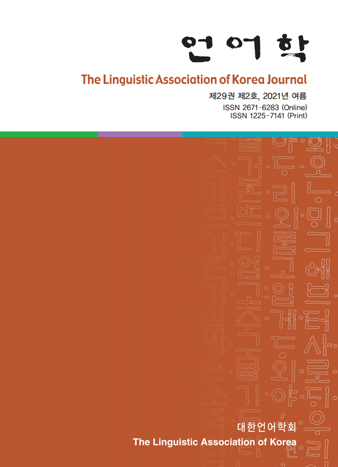대한언어학회 전자저널

29권 2호 (2021년 6월)
- 한국인 영어 학습자들의 함언-비함언 동사에 대한 이해 연구
-
유은지 · 이영주
Pages : 47-70
Abstract
Ryu, Eun Ji & Lee, Youngjoo. (2021). A study on the understanding of implicative and non-implicative verbs by Korean learners of English. The Linguistic Association of Korea Journal, 29(2), 47-70. This paper examines Korean learners understanding of implicative and non-implicative verbs in English. The two types of verbs are distinguished from each other in English by the presence or absence of the entailment of their complement clause. In Korean, by contrast, the validity of the embedded clause does not depend on the verb because the verb itself is not implicative. The implicative meaning arises from complex sentence structures containing certain conjunctive endings. Due to these cross-linguistic differences, Korean learners of English who assume the semantic equivalence of similar corresponding verbs are predicted to rely on their L1 knowledge and fail to distinguish implicative verbs from non-implicative ones. In order to confirm this prediction, this study examined 27 advanced and intermediate Korean learners understanding of English implicative and non-implicative verbs through translation and entailment checking tasks. The results confirmed the prediction: many participants failed to understand the distinction between the two types, and performed particularly poorly on the implicative verbs. The results of this study provide implications for L2 vocabulary teaching and translation training, namely that explicit instruction is required on the entailment component of implicative verbs.
Keywords
# 함언 동사(implicative verbs) # 비함언 동사(non-implicative verbs) # 함의(entailment) # 모국어 전이(L1 transfer) # 의미 전이(semantic transfer)
References
- 국립국어원. (2005). 외국인을 위한 한국어 문법 1. 서울: 커뮤니케이션북스.
- 국립국어원. (2005). 외국인을 위한 한국어 문법 2. 서울: 커뮤니케이션북스.
- 박민신. (2016). 연결어미 ‘-어서’의 다의성 연구. 한국어 의미학, 54, 1-31.
- Beavers, J., & Lee, J. (2020). Intentionality, scalar change, and non-culmination in Korean caused change-of-state predicates. Linguistics, 58(5), 1233-1283.
- Carrell, P. (1984). Inferencing in ESL: Presuppositions and implications of factive and implicative predicates. Language Learning, 34(1), 1-21.
- Givón, T. (1984). Syntax: A functional-typological introduction. Amsterdam: Benjamins Publishing Co.
- Karttunen, L. (1971). Implicative verbs. Language, 47(2), 340-358.
- Karttunen, L. (2012). Simple and phrasal implicatives. In Proceedings of First Joint Conference on Lexical and Computational Semantics, 124-131.
- Kim, J.-Y. (2005). L2 acquisition of transitivity alternations and of the entailment relations for causatives by Korean speakers of English and English speakers of Korean. Unpublished doctoral dissertation, University of Hawaii, Manoa, HI.
- Kim, K., Ko, H., & Yang, H. (2020). Telicity and mode of merge in L2 acquisition of resultatives. Language Acquisition, 27(2), 117-159
- Odin, T. (1989). Language transfer. Cambridge: Cambridge University Press.
- Shim, J., & Lee, H. (2012). An analysis of semantic knowledge of L2 adult learners of English concerning implicative/non-implicative verbs. The Linguistic Association of Korea Journal, 20(2), 23-40.
- Slabakova, R. (2000). L1 transfer revisited: the L2 acquisition of telicity marking in English by Spanish and Bulgarian native speakers. Linguistics, 38(4), 739-770.
- Tomioka, T. (1985). How well can Japanese ESL students draw inferences from English sentences? Kansas Working Papers in Linguistics, 10(1), 56-75.
- Yin, B., & Kaiser, E. (2011). Chinese speakers’ acquisition of telicity in English. In Selected Proceedings of the 2020 Second Language Research Forum, 182-198